大型集装箱船的结构特点及其操纵分析2
浅谈大型集装箱船操纵

在 深水 区速 降 明显 ,但 旋 回 圈小 在 浅 水 区速 降小 ,则 旋 回 圈 大 。 14 船 速 快 第 五 、 第 六 代 集 装 箱船 船 速 均 在 2 — 4节 左 右 ,本 轮 正 常营 32
船 舶尺度大了 ,相应 的船 舶质量也大 ,表 现在船舶运动 中停 船 慢、停 止中起动慢 ,往往要达到理 想的效果需等待较长 的时间 ,
这 一点对 经常在 小型船 上做 的船长 来讲一 定要有 个清 晰的认 识 ; 船 舶 面 积 大 ,受 风 流 等 外 力 的影 响 也 大 ,通 常表 现 为 满 载 时 受 流 影 响 大 ,空 载 时 受 风 影 响 大 ,这 对 船 舶 靠 离 泊 或 在 拥 挤 的 锚 地 抛 锚 时 尤 需 注 意 :船 舶 尺 度 大 了 .盲 区 也 大 ,特 别是 当 吃 水 差 较 大
15 浅 水 效 应 明显
绝 同样 的事故和 ( ) 或 类似 的事故在 自己身上再次发 生,以实现 安全最 大化 、效益理 想化 的最终 目标。 3 大型船舶的操作的方法
31 航 行安 全 操 作 由 于 大 型 船 舶 行 动 呆 笨 ,盲 区 大 ,一 般 在 O3海 里 以 上 , 速 度 快 等 特 性 , 因此 在 操 作 中要 做 到 以下 几 点 : 保 持 正 规 了望 ,这 种 了望 包 括 视 觉 、听 觉 、雷 达 、V 、AI HF S
根据进港指南 和航 路指南等资料 ,详 细了解相关航 区的船舶 通航情况 、气 象天气条件 、潮 流潮汐情况 、航 区海况特点 、海 峡
水 道 的 Y S报 告 要 求 等 。 认 真 仔 细 查 阅 有 关 航 用 海 图 、洋 流 图 、 T 进 港 指 南 、航 路 指 南 、 无 线 电 信 号 规 则 、 气 象 和 水 文 资 料 、港 口
三船舶分类和结构特点
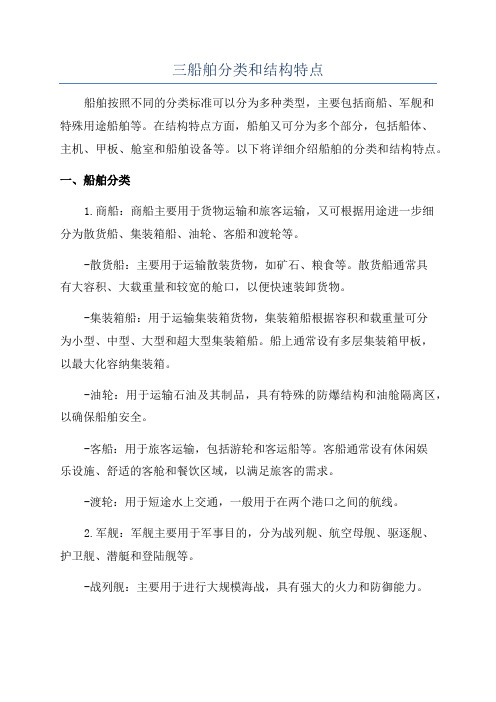
三船舶分类和结构特点船舶按照不同的分类标准可以分为多种类型,主要包括商船、军舰和特殊用途船舶等。
在结构特点方面,船舶又可分为多个部分,包括船体、主机、甲板、舱室和船舶设备等。
以下将详细介绍船舶的分类和结构特点。
一、船舶分类1.商船:商船主要用于货物运输和旅客运输,又可根据用途进一步细分为散货船、集装箱船、油轮、客船和渡轮等。
-散货船:主要用于运输散装货物,如矿石、粮食等。
散货船通常具有大容积、大载重量和较宽的舱口,以便快速装卸货物。
-集装箱船:用于运输集装箱货物,集装箱船根据容积和载重量可分为小型、中型、大型和超大型集装箱船。
船上通常设有多层集装箱甲板,以最大化容纳集装箱。
-油轮:用于运输石油及其制品,具有特殊的防爆结构和油舱隔离区,以确保船舶安全。
-客船:用于旅客运输,包括游轮和客运船等。
客船通常设有休闲娱乐设施、舒适的客舱和餐饮区域,以满足旅客的需求。
-渡轮:用于短途水上交通,一般用于在两个港口之间的航线。
2.军舰:军舰主要用于军事目的,分为战列舰、航空母舰、驱逐舰、护卫舰、潜艇和登陆舰等。
-战列舰:主要用于进行大规模海战,具有强大的火力和防御能力。
-航空母舰:主要用于携带和发射舰载机,可远距离攻击敌方目标,具有战略意义。
-驱逐舰:主要用于护航和反潜作战,拥有较高的航速和火力。
-护卫舰:主要用于辅助驱逐舰进行护航任务,装备较轻的武器系统。
-潜艇:用于在水下进行隐蔽作战,分为核动力潜艇和常规动力潜艇。
-登陆舰:主要用于进行登陆作战,装载人员、装备和物资等。
3.特殊用途船舶:特殊用途船舶主要包括科学考察船、渔船、救助船、工程船和拖船等。
-科学考察船:主要用于海洋科学研究和勘测工作,配备科研设备和实验室。
-渔船:用于捕捞鱼类和其他水产品,各地的渔船类型和结构会有所不同。
-救助船:主要用于海上救援和打捞工作,配备救生设备和救援装备。
-工程船:用于水下工程和航道维护等工作,例如测绘船和挖泥船等。
-拖船:用于拖引其他船舶或浮筒等,具有较大的牵引力。
18000TEU超大集装箱船舵鳍分段结构特点及建造工艺研究
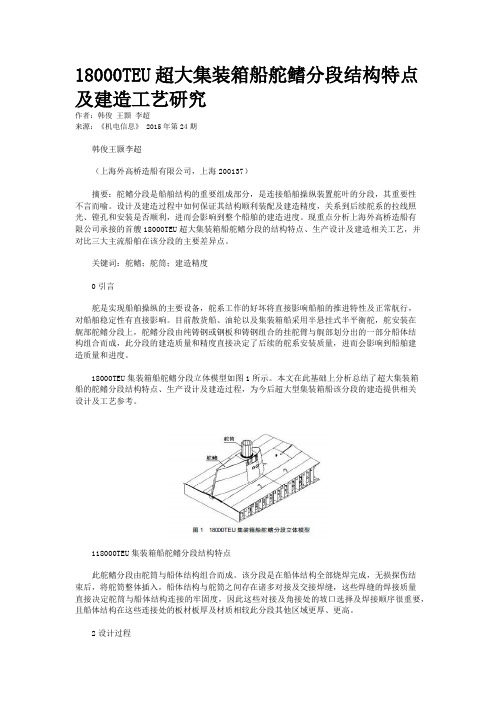
18000TEU超大集装箱船舵鳍分段结构特点及建造工艺研究作者:韩俊王颢李超来源:《机电信息》 2015年第24期韩俊王颢李超(上海外高桥造船有限公司,上海200137)摘要:舵鳍分段是船舶结构的重要组成部分,是连接船舶操纵装置舵叶的分段,其重要性不言而喻。
设计及建造过程中如何保证其结构顺利装配及建造精度,关系到后续舵系的拉线照光、镗孔和安装是否顺利,进而会影响到整个船舶的建造进度。
现重点分析上海外高桥造船有限公司承接的首艘18000TEU超大集装箱船舵鳍分段的结构特点、生产设计及建造相关工艺,并对比三大主流船舶在该分段的主要差异点。
关键词:舵鳍;舵筒;建造精度0引言舵是实现船舶操纵的主要设备,舵系工作的好坏将直接影响船舶的推进特性及正常航行,对船舶稳定性有直接影响。
目前散货船、油轮以及集装箱船采用半悬挂式半平衡舵,舵安装在艉部舵鳍分段上,舵鳍分段由纯铸钢或钢板和铸钢组合的挂舵臂与艉部划分出的一部分船体结构组合而成,此分段的建造质量和精度直接决定了后续的舵系安装质量,进而会影响到船舶建造质量和进度。
18000TEU集装箱船舵鳍分段立体模型如图1所示。
本文在此基础上分析总结了超大集装箱船的舵鳍分段结构特点、生产设计及建造过程,为今后超大型集装箱船该分段的建造提供相关设计及工艺参考。
118000TEU集装箱船舵鳍分段结构特点此舵鳍分段由舵筒与船体结构组合而成。
该分段是在船体结构全部烧焊完成,无损探伤结束后,将舵筒整体插入,船体结构与舵筒之间存在诸多对接及交接焊缝,这些焊缝的焊接质量直接决定舵筒与船体结构连接的牢固度,因此这些对接及角接处的坡口选择及焊接顺序很重要,且船体结构在这些连接处的板材板厚及材质相较此分段其他区域更厚、更高。
2设计过程随着公司造船效率的不断提升,生产部门对设计图纸的质量要求也在提高。
设计是生产的先行,设计时考虑得越周到细致,给生产现场带来的便利就越大。
因此,在舵鳍分段的结构设计过程中对具体的焊接坡口、具体的建造方式以及为顾及施工方便而进行合理化设计等各方面都需要予以全面细致的考虑,以确保分段建造的质量。
超大型集装箱船舶标准
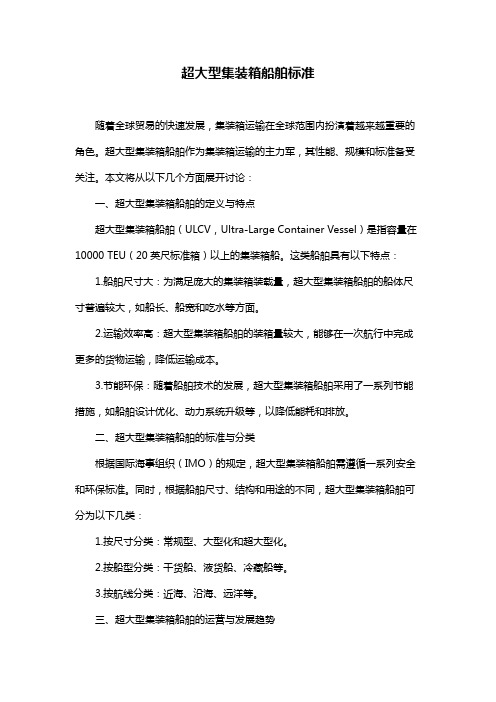
超大型集装箱船舶标准随着全球贸易的快速发展,集装箱运输在全球范围内扮演着越来越重要的角色。
超大型集装箱船舶作为集装箱运输的主力军,其性能、规模和标准备受关注。
本文将从以下几个方面展开讨论:一、超大型集装箱船舶的定义与特点超大型集装箱船舶(ULCV,Ultra-Large Container Vessel)是指容量在10000 TEU(20英尺标准箱)以上的集装箱船。
这类船舶具有以下特点:1.船舶尺寸大:为满足庞大的集装箱装载量,超大型集装箱船舶的船体尺寸普遍较大,如船长、船宽和吃水等方面。
2.运输效率高:超大型集装箱船舶的装箱量较大,能够在一次航行中完成更多的货物运输,降低运输成本。
3.节能环保:随着船舶技术的发展,超大型集装箱船舶采用了一系列节能措施,如船舶设计优化、动力系统升级等,以降低能耗和排放。
二、超大型集装箱船舶的标准与分类根据国际海事组织(IMO)的规定,超大型集装箱船舶需遵循一系列安全和环保标准。
同时,根据船舶尺寸、结构和用途的不同,超大型集装箱船舶可分为以下几类:1.按尺寸分类:常规型、大型化和超大型化。
2.按船型分类:干货船、液货船、冷藏船等。
3.按航线分类:近海、沿海、远洋等。
三、超大型集装箱船舶的运营与发展趋势1.航线布局:随着全球贸易的增长,超大型集装箱船舶主要运营在亚欧、北美、中东等主要贸易航线。
2.船舶订单:近年来,我国船东对新造超大型集装箱船舶的需求不断增加,订单量占据全球市场份额较大。
3.发展趋势:绿色、智能化和无人驾驶将成为超大型集装箱船舶未来发展的重要方向。
四、我国在超大型集装箱船舶领域的现状与挑战1.现状:我国已成为全球最大的超大型集装箱船舶建造国,拥有较高的设计和制造水平。
2.挑战:船舶核心技术、绿色船舶技术、船舶智能化等方面与国际先进水平仍有一定差距。
五、应对挑战,提升我国超大型集装箱船舶产业的策略1.加大科技创新力度,突破关键技术。
2.推广绿色船舶技术,提高船舶能效。
超大型集装箱船舶工艺设计分析
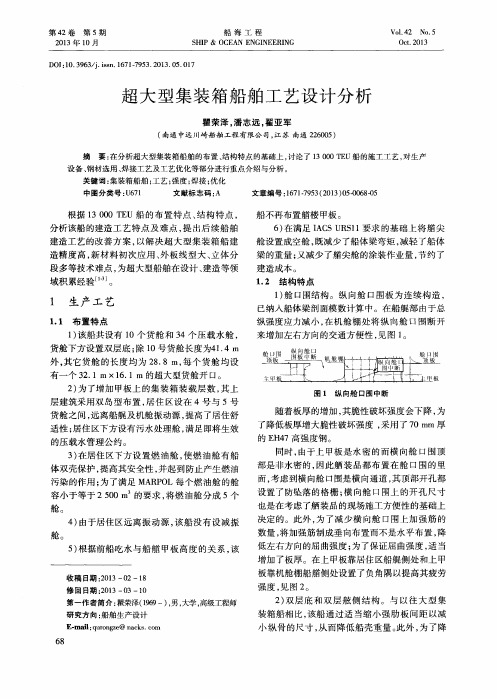
I
图 5 取 消 中 垂 桁 材 示 意
低船 壳重量 , 舷侧肋板也 采用 了开 口构 造 。为 了满
足水 密横舱 壁和双层底 交叉部位 的疲 劳强度 要求 , 对 双层底 和纵桁进行 了局部增厚 补强 , 见图 3 。
设备 、 钢材选用 、 焊接工艺及工艺优化等部分进行重点介绍与分析 。
关键词 : 集装箱船舶 ; 工艺 ; 强度 ; 焊接 ; 优化
中 图分 类 号 : U 6 7 1 文献标志码 : A 文章编号 : 1 6 7 1 . 7 9 5 3 ( 2 0 1 3 ) 0 5 - 0 0 6 8 - 0 5
板 靠机 舱棚船 艏侧 处设 置 了负角 隅以提 高其 疲劳
强度 , 见图 2 。
第一作者简介 : 瞿荣泽( 1 9 6 9一) , 男, 大学, 高级工程师 研 究方向 : 船舶生产设计
E- ma i l : q u r o n g z e @n a c k s . c o m
2 ) 双层 底 和 双 层 舷 侧 结 构 。 与 以 往 大 型 集 装箱船 相 比 , 该船 通 过 适 当缩 小 强 肋 板 间距 以减
舱设 置成 空舱 , 既减少 了船体 梁弯 矩 , 减 轻 了船体 梁 的重量 ; 又减 少 了艏尖舱 的涂装 作业 量 , 节约 了
建造 成本 。 1 . 2 结构 特点
造精度高 , 新材料初次应用 、 外板线型大 、 立体分 段多等技术难点, 为超大型船舶在设计、 建造等领
域积 累经 验 _ 1 引。
1 生 产 工 艺
1 . 1 布 置特 点
1 ) 舱 口围结 构 。纵 向舱 口围板 为 连 续 构造 ,
大型集装箱船的结构特点及其操纵分析2
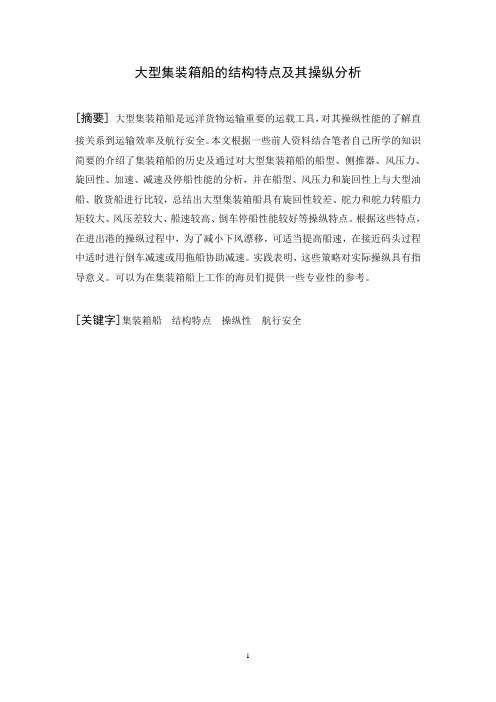
大型集装箱船的结构特点及其操纵分析[摘要]大型集装箱船是远洋货物运输重要的运载工具,对其操纵性能的了解直接关系到运输效率及航行安全。
本文根据一些前人资料结合笔者自己所学的知识简要的介绍了集装箱船的历史及通过对大型集装箱船的船型、侧推器、风压力、旋回性、加速、减速及停船性能的分析,并在船型、风压力和旋回性上与大型油船、散货船进行比较,总结出大型集装箱船具有旋回性较差、舵力和舵力转船力矩较大、风压差较大、船速较高、倒车停船性能较好等操纵特点。
根据这些特点,在进出港的操纵过程中,为了减小下风漂移,可适当提高船速,在接近码头过程中适时进行倒车减速或用拖船协助减速。
实践表明,这些策略对实际操纵具有指导意义。
可以为在集装箱船上工作的海员们提供一些专业性的参考。
[关键字]集装箱船结构特点操纵性航行安全Large container ship’s structural characteristics and analysis of itsmanipulation[Abstract] Large ocean-going cargo container ship is an important means of delivery, understanding its maneuverability is directly related to transport efficiency and safety of navigation. Information according to some combination of the previous paper the author learned in his brief introduction to the history of container ships and large container ship by ship, tunnel thrusters, wind pressure, gyration, acceleration, deceleration and stopping performance analysis, and In the ship, the wind pressure and the gyration with large oil tankers, bulk carriers were compared, summed up the large container ships with a cycle of poor rudder force and moment of a larger rudder, turned the ship, the wind pressure greater, speed high, reversing stopping manipulation features such as better performance. According to these characteristics, manipulation of the process in and out of port, in order to reduce downwind drift, it is appropriate to improve the speed of the ship, near the Pier during the slowing down or reversing a timely manner to assist with the tug to slow down. Practice shows that these strategies provide guiding significance for the actual manipulation of ship. And it could provide some professional reference for the seafarers working on container ship.[Key words] container ship structural features maneuverability Navigation Safety目录引言 (5)第一章集装箱船概论 (6)1.1集装箱船大型化的发展历程 (6)1.2 大型集装箱船的市场介绍 (6)第二章大型集装箱船的结构分析 (8)2.1 大型集装箱船的船型特点及其对船舶操纵性能的影响 (8)2.1.1长宽比 (8)2.1.2方形系数 (8)2.1.3舵面积与船长吃水比 (8)2.1.4单位载重吨分配的主机功率 (9)2.2 大型集装箱船的侧推器 (10)2.3大型集装箱船的风压力 (10)第三章大型集装箱船的操纵性 (12)3.1 旋回性 (12)3.1.1旋回圈几何要素 (12)3.1.2 旋回过程中的速度降低和旋回时间 (13)3.2大型集装箱船的加速、减速和停船性能 (13)第四章大型集装箱船的一些安全操作 (15)4.1用好先进的导航设备 (15)4.2 采用车速避让时需大幅度 (16)4.3熟悉船舶的操纵数据应用在实践中 (16)4.4 大风浪中的注意事项 (16)4.5 抵港前根据船舶密度适时调整船速 (17)4.6 对小渔船的避让 (17)4.7 把握船舶驾驶员的避碰心理 (18)结论 (19)致谢辞 (20)参考文献 (21)引言集装箱船舶首次出现于20世纪50年代,此后国际海上集装箱运输曾经历几代的发展。
超大型集装箱船舶标准

超大型集装箱船舶标准
超大型集装箱船舶的标准包含以下几个方面:
船长:船长为275-295米,船宽约32.2-39.4米,吃水为11.5-13.5米,舱内装10-11列,8-9层,甲板上装13-14列,4-5层。
载箱量:载箱量为3000-4000TEU,载重量为40000-50000t。
船型:根据不同的船型,超大型集装箱船可以分为第五代集装箱船、第六代集装箱船、第七代集装箱船等。
装卸效率高:超大型集装箱船舶的装卸效率非常高,通常可以在短时间内完成大量集装箱的装卸。
经济性:由于规模经济效应,超大型集装箱船舶的成本相对较低,使得其在航运市场中具有更强的竞争力。
环保性:超大型集装箱船舶通常采用新型高效节能设备,能够降低能源消耗和二氧化碳排放,对环保具有积极作用。
安全性:超大型集装箱船舶在设计时充分考虑了安全因素,采用先进的安全管理系统和设备,确保船员和货物的安全。
超大型集装箱船舶作为现代航运的重要组成部分,具有高效、经济、环保和安全等特点,为全球贸易和物流体系的发展做出了重要贡献。
5800TEU集装箱船舶的操纵性及操纵注意事项
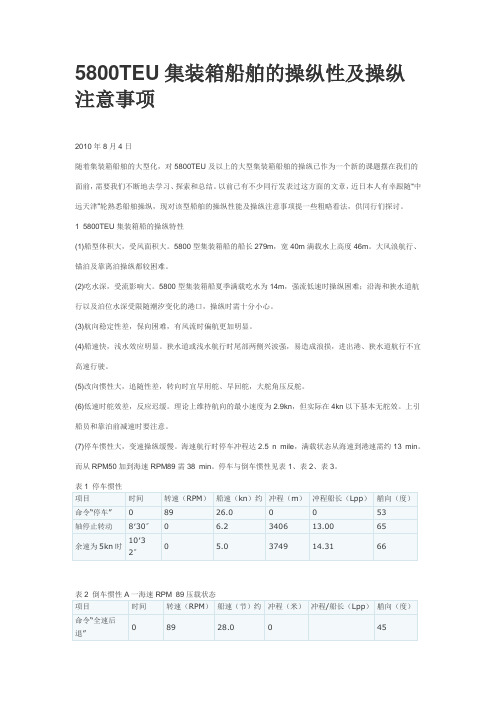
5800TEU集装箱船舶的操纵性及操纵注意事项2010年8月4日随着集装箱船舶的大型化,对5800TEU及以上的大型集装箱船舶的操纵已作为一个新的课题摆在我们的面前,需要我们不断地去学习、探索和总结。
以前已有不少同行发表过这方面的文章,近日本人有幸跟随“中远天津”轮熟悉船舶操纵,现对该型船舶的操纵性能及操纵注意事项提一些粗略看法,供同行们探讨。
1 5800TEU集装箱船的操纵特性(1)船型体积大,受风面积大。
5800型集装箱船的船长279m,宽40m满载水上高度46m。
大风浪航行、锚泊及靠离泊操纵都较困难。
(2)吃水深,受流影响大。
5800型集装箱船夏季满载吃水为14m,强流低速时操纵困难;沿海和狭水道航行以及泊位水深受限随潮汐变化的港口,操纵时需十分小心。
(3)航向稳定性差,保向困难,有风流时偏航更加明显。
(4)船速快,浅水效应明显。
狭水道或浅水航行时尾部两侧兴波强,易造成浪损,进出港、狭水道航行不宜高速行驶。
(5)改向惯性大,追随性差,转向时宜早用舵、早回舵,大舵角压反舵。
(6)低速时舵效差,反应迟缓。
理论上维持航向的最小速度为2.9kn,但实际在4kn以下基本无舵效。
上引船员和靠泊前减速时要注意。
(7)停车惯性大,变速操纵缓慢。
海速航行时停车冲程达2.5 n mile,满载状态从海速到港速需约13 min。
而从RPM50加到海速RPM89需38 min。
停车与倒车惯性见表1、表2、表3。
(8)盲区大,船首尾方向瞭望困难。
5800型集装箱船满载时船首盲区近500m,船尾盲区达780 m。
(9)旋回性能好,旋回圈大,旋回中速度下降明显。
满载24.8 kn速度旋回直径在9.3 cab,旋回一周速度下降至14.1 kn,旋回时间10 min18 s。
由此可见:超大型船舶因其质量大,惯性也大,冲程、冲时均长。
满载时由船速26kn到余速5kn时的冲程约在14L以上。
起始时由于水阻力的因素速度下降明显,其后期因阻力的减弱,对质量巨大的船舶影响也相应减弱,从而使船舶很难完全停住。
集装箱船舶
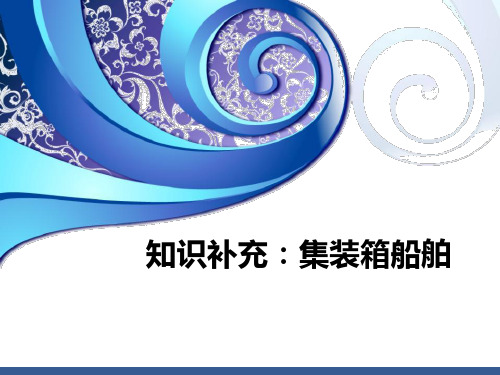
5、集装箱预配图编制要求 (1)保证船舶的稳性。 (2)保持适当吃水差。 (3)充分利用船舶的箱位。 (4)保持船舶的纵向强度。 (5)尽量避免中途港倒箱。 (6)消除重点舱。 (7)装卸作业中能保持船舶左右平衡。 (8)注意特种箱的配载。
第五节 集装箱船队的机构设置
• 机构设置的意义 是企业存在的主要形式。 • 机构设置的基本原则 实施各项管理职能、实现-协调、制约的效果-形成高效运营 机制。 • 制约的核心 规避企业的经营风险和机制风险。 航运企业的运营风险:经营经营业务波动风险。 机制风险:人才、资产的风险。 该核心是打造企业经营管理模式的基础和保证。
(2)超长、超宽货物:因尺寸、规格的特殊,通常放在 甲板最上层。 (3)通风保鲜箱:装运蔬菜、水果的通风箱,要求安置 在甲板上,通风好处,要配备帆布遮盖。
(4)牲畜箱:要求在甲板上通气、避风处,备帆布以保
暖用。
注意:航行时间长,一定要求托运人备好牲畜饲料。
(5)装载危险品货箱:一般在船上有指定区域,在紧急 情况下可应急处理。
四、集装箱船舶的配积载图 现在已经基本由计算机设计完成。 1.集装箱积载位置的表示方法 (1)排位(BAY)表示方法 从船尾到船首,按奇数顺序排列,如编号01,03,……表 示每排单位长度为:20’。 (2)列位(ROW)表示方法 从驾驶室向下俯视,以中剖线为基准,向右舷以奇数,向左 舷以偶数按顺序排列。 (3)层位(TIRE)表示方法 甲板上,自下而上82,84,86,……;或D1,D2, D3,……。 船舱内,自下而上02,04,06,……;或H1,H2, H3,……。
在自主模式下,集装箱航线的经营特点: 定期班轮:定点、定线、定时、定价,这是真正意义上 的班轮。
资本配置:船舶规模与集装箱数量的合理配置。
三大主流船舶结构特点
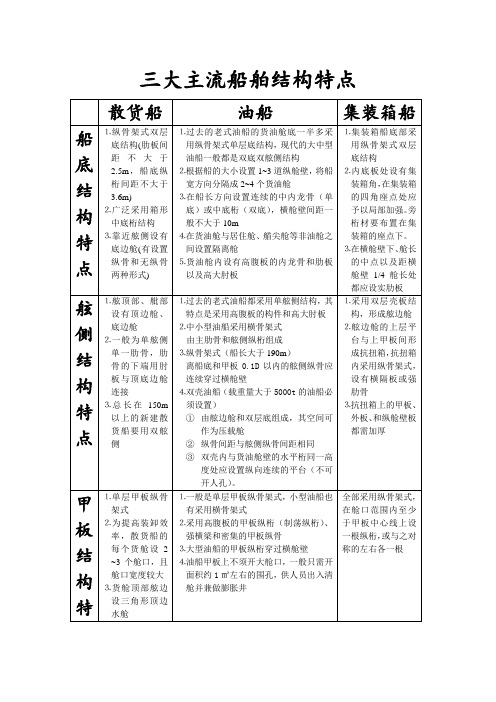
⒊抗扭箱上的甲板、外板、和纵舱壁板都需加厚
甲板结构特点
⒈单层甲板纵骨架式
⒉为提高装卸效率,散货船的每个货舱设2 ~3个舱口,且舱口宽度较大
⒊货舱顶部舷边设三角形顶边水舱
⒈一般是单层甲板纵骨架式,小型油船也有采用横骨架式
⒉采用高腹板的甲板纵桁(制荡纵桁)、强横梁和密集的甲板纵骨
⒊纵骨架式(船长大于190m)
离船底和甲板0.1D以内的舷侧纵骨应连续穿过横舱壁
⒋双壳油船(载重量大于5000t的油船必须设置)
1由舷边舱和双层底组成,其空间可作为压载舱
2纵骨间距与舷侧纵骨间距相同
3双壳内与货油舱壁的水平桁同一高度处应设置纵向连续的平台(不可开人孔)。
⒈采用双层壳板结构,形成舷边舱
⒊在横舱壁下、舱长的中点以及距横舱壁1/4舱长处都应设实肋板
舷侧结构特点
⒈舷顶部、舭部设有顶边舱、底边舱
⒉一般为单舷侧单一肋骨,肋骨的下端用肘板与顶底边舱连接
⒊总长在150m以上的新建散货船要用双舷侧
⒈过去的老式油船都采用单舷侧结构,其特点是采用高腹板的构件和高大肘板
⒉中小型油船采用横骨架式
由主肋骨和舷侧纵桁组成
三大主流船舶结构特点
散货船
油船
集装箱船
船底结构特点
⒈纵骨架式双层底结构(肋板间距不大于2.5m,船底纵桁间距不大于3.6m)
⒉广泛采用箱Biblioteka 中底桁结构⒊靠近舷侧设有底边舱(有设置纵骨和无纵骨两种形式)
⒈过去的老式油船的货油舱底一半多采用纵骨架式单层底结构,现代的大中型油船一般都是双底双舷侧结构
⒉根据船的大小设置1~3道纵舱壁,将船宽方向分隔成2~4个货油舱
大型集装箱船结构特点及其操纵分析

大型集装箱船的结构特点及其操纵分析[摘要]大型集装箱船是远洋货物运输重要的运载工具,对其操纵性能的了解直接关系到运输效率及航行安全。
本文根据一些前人资料结合笔者自己所学的知识简要的介绍了集装箱船的历史及通过对大型集装箱船的船型、侧推器、风压力、旋回性、加速、减速及停船性能的分析,并在船型、风压力和旋回性上与大型油船、散货船进行比较,总结出大型集装箱船具有旋回性较差、舵力和舵力转船力矩较大、风压差较大、船速较高、倒车停船性能较好等操纵特点。
根据这些特点,在进出港的操纵过程中,为了减小下风漂移,可适当提高船速,在接近码头过程中适时进行倒车减速或用拖船协助减速。
实践表明,这些策略对实际操纵具有指导意义。
可以为在集装箱船上工作的海员们提供一些专业性的参考。
[关键字]集装箱船结构特点操纵性航行安全Large container ship’s structural characteristics and analysis of itsmanipulation[Abstract]Large ocean-going cargo container ship is an important means of delivery, understanding its maneuverability is directly related to transport efficiency and safety of navigation. Information according to some combination of the previous paper the author learned in his brief introduction to the history of container ships and large container ship by ship, tunnel thrusters, wind pressure, gyration, acceleration, deceleration and stopping performance analysis, and In the ship, the wind pressure and the gyration with large oil tankers, bulk carriers were compared, summed up the large container ships with a cycle of poor rudder force and moment of a larger rudder, turned the ship, the wind pressure greater, speed high, reversing stopping manipulation features such as better performance. According to these characteristics, manipulation of the process in and out of port, in order to reduce downwind drift, it is appropriate to improve the speed of the ship, near the Pier during the slowing down or reversing a timely manner to assist with the tug to slow down. Practiceshows that these strategies provide guiding significance for the actual manipulation of ship. And it could provide some professional reference for theseafarers working on container ship. [Key words] container ship structural features maneuverabilityNavigation Safety目录引言5第一章集装箱船概论61.1集装箱船大型化的发展历程61.2 大型集装箱船的市场介绍6第二章大型集装箱船的结构分析82.1 大型集装箱船的船型特点及其对船舶操纵性能的影响82.1.1长宽比82.1.2方形系数92.1.3舵面积与船长吃水比92.1.4单位载重吨分配的主机功率92.2 大型集装箱船的侧推器102.3大型集装箱船的风压力10第三章大型集装箱船的操纵性123.1 旋回性133.1.1旋回圈几何要素133.1.2 旋回过程中的速度降低和旋回时间133.2大型集装箱船的加速、减速和停船性能14第四章大型集装箱船的一些安全操作154.1用好先进的导航设备164.2 采用车速避让时需大幅度164.3熟悉船舶的操纵数据应用在实践中174.4 大风浪中的注意事项174.5 抵港前根据船舶密度适时调整船速184.6 对小渔船的避让184.7 把握船舶驾驶员的避碰心理18结论19致谢辞20参考文献21引言集装箱船舶首次出现于20世纪50年代,此后国际海上集装箱运输曾经历几代的发展。
大型滚装船港内操纵探讨

侧 推 器 的 侧 推 力 不仅 与 它 的 功 率
将跳 板 放 到码 头 上 , 汽 车 或 拖 车 通 层甲板 。 驾 驶室通常布置在首部起 居 有关 , 也与船 舶载况 和 船速 有关, 其 过 跳 板 开上 开 下 , 驶到船 舱的各层 甲 室之 上, 最 顶层的舱室就 是驾驶室 , 中侧 推 器 的功 率 与船 舶 的吨 位 大 小 相
1 .滚装 船
搭载 5 0 0 0 辆 ( 汽车 和轻型卡车 ) 或超 器作为船舶 的辅助操纵装 置, 在港内
过一 千辆 的装 甲车 辆 。 1 . 3 滚 装 船 的特 点 船 舶 操 纵 中 得 到 了广 泛 的应 用 。 如 靠 离码 头 中 船 舶 的 横 向 移 动 、 航 道 内低
如 图3 ) 。 出流方 向垂直于船舶 首尾线 , 发 出 的 码 头 (
小 船 的动 态 , 夜 间 可 用探 照 灯 对 着 有 碰 撞 危 险 的他 船 的 方 向照 射 , 以表 明 我船的存在 , 引起 他 船对 碰 撞 危 险 的
警觉 , 双方极早采取避让 措施 。 有 些 航 经 附 近 的小 船 在 左舷 闪红 灯 , 表 示
板, 实 现 货 物 的装 卸 , 故又称 “ 开上 开 机 舱 在 尾 部 , 烟 囱置于尾部 两舷 , 巨 适 应。 船速是 影响侧推力的最主要的 下” 船, 或称 “ 滚 上滚 下 ” 船。
1 . 2 滚 装 船 的发 展 滚 装 船 是 在 汽 车 轮 渡 的 基 础 上
大 的船体 内部就是货舱 。 船首部大 都 外 部 因 素 , 船舶 静止时 , 侧 推 器 的 排
滚装船和其它运输船舶相 比, 无 速 航 行 时 调 整 航 向 、 协 助 船 、 舱室 布置 水 域掉头 、 抑制倒 车过 程中的船首偏
强拢风天气下大型集装箱船靠泊青岛港分析

强拢风天气下大型集装箱船靠泊青岛港分析作者:李磊来源:《中国水运》2016年第06期摘要:随着造船技术的飞速发展,船舶大型化的脚步也不断加快,集装箱船的大型化就是典型代表,在E级集装箱船带来的震撼还未消退,3E级集装箱船已经频繁来往于世界各大港口,作为一名引航员,如何更好的分析和在恶劣天气下安全驾引这些海上巨无霸就显得尤为重要。
关键词:强拢风;大型集装箱船;风动压力中图分类号:U675.5+1 文献标识码:A 文章编号:1006-7973(2016)06-0048-03青岛港是我国重要的沿海国际大港,吞吐量名列世界前茅,其中集装箱吞吐量2015年排名世界第七,中国第六(含香港港),集装箱船的引领占青岛港引航员引领工作的大部分,因此做好集装箱船的安全引领工作为整个港口的安全引航起到至关重要的作用。
由于集装箱船的特殊船型构造和装载方式,在影响船舶运动的各种自然外力中,风对集装箱船的影响特别明显,引航员为了更好地驾引大型集装箱船,需要对此类船舶在强拢风天气下靠泊进行认真分析,以便做到安全高效引航,保证引航服务效率。
1.青岛港港区风的基本情况青岛属于海洋性季风气候,冬季受西伯利亚地区移来的冷高压影响,夏季受西太平洋副热带高压控制。
两者为不同属性的半永久性高压。
3月中旬开始,由于冷高压在海上停留冻南风显占优势。
仲秋开始,极地冷空气活跃,北向风重占优势。
受地形影响,终年多东南和西北两个风向。
年平均风速4.9m/s,各月平均风速以3月最强为5.6m/s,9月最弱为4.1m/s。
百年以来,平均风速最强的时次为1923年11月24日,北北西风32.4m/s.瞬间最大风速则首推1939年8月31日之北北东风40.3m/s,前者受寒潮影响,后者为台风所造成。
特别是冬季寒潮天气,阵风7~8级经常出现,而且来势迅猛,给引航工作造成很大麻烦,如果不做好充分的安全措施,极易发生事故。
2.大型集装箱船的操纵特点和靠泊要求大型集装箱船的操纵特点除了具有惯性大,旋回水域宽外,还具有以下特点:2.1船舶尺度明显增大以目前最大的3E级集装箱为例,其船长399米、宽59米、型深30米、最大吃水16米、最大高度约70米、带缆甲板高度约21米(部分达到25米),尺度的增大,船舶受风流影响的面积也增大,对于3E级集装箱侧面最大受风面积可达15000m2,在大风天气下给船舶操纵带来极大困难。
大型集装箱船舶的结构特点及操纵性能
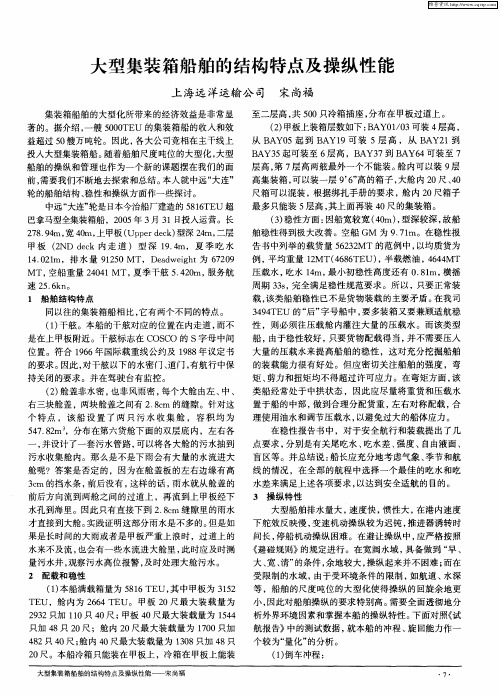
并设计了一套污水管路 , 可以将各大舱的污水抽到 污水收 集舱 内。那 么是 不 是下 雨 会有 大 量 的水 流进 大
,
盲区等。并总结说 : 船长应充分地考虑气象 、 季节和航
线的情况 ,在全部 的航程 中选择一个最佳 的吃水和吃 水差来满足上述各项要求 , 以达到安全适航的 目的 。
上 海远 洋运输公 司 宋尚福
集装箱船舶 的大型化所带来 的经济效益是非常显 著的。据介绍 , 一艘 50T U 的集装箱船的收入和效 00 E 益超过 5 艘万吨轮 。因此 , 0 各大公司竞相在主干线上 投人大型集装箱船。 随着船舶尺度吨位的大型化 , 大型 至二层高 , 5 0 共 0 只冷箱插座 , 分布在甲板过道上 。 () 2 甲板上装箱层数如下 :A 10 可装 4 B Y0 /3 层高 , 从 B Y 5 到 B Y1 装 5 高 ,从 B Y2 到 A O起 A 9可 层 A 1 B Y5 A 3 起可装至 6 层高 ,B Y3 A 7到 B Y6 可装至 7 A 4 层高 , 7 第 层高两舷最外一个不能装 。 内可以装 9 舱 层 高集装箱 , 以装一层 96 高的箱子 , 可 ’” 大舱 内 2 尺 、0 0 4 尺箱可以混装 , 根据绑扎手册的要求 , 舱内 2 尺箱子 0
TE U,舱 内 为 2 6 EU。 甲 板 2 6 4T 0尺 最 大 装 载 量 为 23 92只加 10只 4 1 0尺 ; 甲板 4 最 大装 载量 为 14 0尺 54 只加 4 8只 2 0尺 ;舱 内 2 最 大装 载 量 为 10 0尺 7 0只加 4 2只 4 8 0尺 ; 内 4 最 大装 载量 为 10 舱 0尺 38只加 4 8只
同以往的集装箱船相比, 它有两个不 同的特点。 () 1干舷。本船的干舷对应的位置在 内走道 , 而不 是在上甲板附近 。干舷标 志在 C S O 的 S OC 字母 中间 位置 。符合 16 年国际载重线公约及 18 年议定书 96 98 的要 求 。 因此 , 对干 舷 以下 的水 密 门 、 门 , 航 行 中保 道 有
2.船舶总体构造名称-2
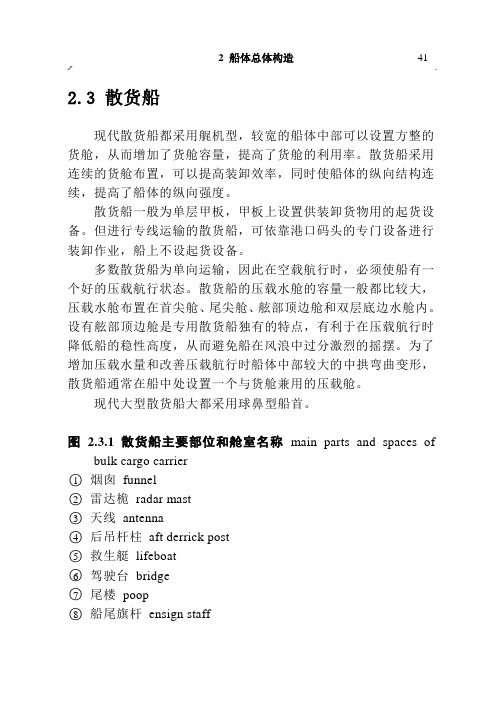
舵机舱steering gear room,steeringengine room
舵rudder
螺旋桨screw propeller
艉尖舱aft peak tank
水密横向舱壁watertight transverse bulkhead
船尾旗杆ensign staff
舵机舱steering gear room, steeringengine room
舵rudder
螺旋桨screw propeller
尾尖舱aft peak tank
机舱engine room
燃油舱fuel oil tank
隔离空舱cofferdam
货舱cargo hold
集装箱船为“尾机型船”,机舱和上层建筑均设在船尾部位。船体的线型比较削瘦,航速较高,一般船首为球鼻艏型。集装箱船一般设有长的艏楼,艏楼甲板上一般不堆放集装箱。
现代的集装箱船都设计为双层船壳。舷侧的双壳内通常设有通道和压载水舱或燃油舱。
集装箱船的甲板和货舱盖上可堆放集装箱,并设有专用的集装箱绑扎设备。
舵机舱steering gear room,steeringengine room
舵rudder
螺旋桨screw propeller
艉尖舱aft peak tank
机舱engine room
燃油舱fuel oil tank
隔离舱cofferdam
货舱cargo hold
压载舱ballast tank
空舱light hold
防撞舱壁collision bulkhead
艏尖舱fore peak tank
在强风中操纵大型集装箱船进港靠泊操作概要及注意事项

收稿日期:2018-02-19作者简介:王少彬(1982-),男,河北邢台人,津港引航中心一级引航员,研究方向为船舶操纵。
在强风中操纵大型集装箱船进港靠泊操作概要及注意事项王少彬摘 要:根据天津港的实际情况,详细分析和举例了大型集装箱船进港过程中,遇到强风天气靠泊的全过程,深入探究强风天气下控制大型集装箱船靠泊方法、注意事项、安全措施与建议,为相关人员提供参考。
关键词:大型集装箱船;操纵;强风;风向中图分类号:U675.9 文献标识码:A 文章编号:1006-7973(2018)05-0029-02引言本文所指的大型集装箱船具有方形系数小、长宽比大、船体干舷高、船首部纵向削切距离长、向上向外延展范围大、船舶箱体部分占船体纵向比例小等结构特点。
受船舶建造结构及积载高度影响,该类船不仅受风压作用明显,而且也给拖轮作业带来不少困难。
一、靠泊操作概要在引言中已谈到强风所致风压对该类船的作用十分明显。
为确保在强风中安全顺利地完成靠泊任务,特别是在入泊阶段,在操纵船舶靠泊过程中应尽可采取适当措施减小风压的影响,避免因强风作用导致危险局面形成。
很明显,在入泊阶段操纵的主要考虑因素就是真风向;应通过改变船首向减小风舷角,进而减小船体所受风压,用时间换安全。
在此需要说明的是在下文提及的风向均以泊位线走向为参照,即横风与泊位线成70~90°夹角,八字风与泊位线成30~70°夹角。
据个人经验,在正横风中靠泊风险最大,其次是在前八字拢风中,再次是在后八字开风中;在其它风向中靠泊较为容易,就不在文中讨论了。
1.在强横拢风中靠泊在强横拢风中操纵该类型船靠泊时应采用俗称“拉大网”的方式。
(1)摈弃所谓的入泊三要素。
操纵船舶直接驶抵泊位外挡上风位臵,并保持船体距泊位横距大于3倍船宽。
根据风至飘移速度公式0.140.50.038(/)x v y a a v B Ld e v -= (1) 可知船舶行驶速度越慢,风致船舶横向漂移的速度越快。
集装箱船舶的结构特点
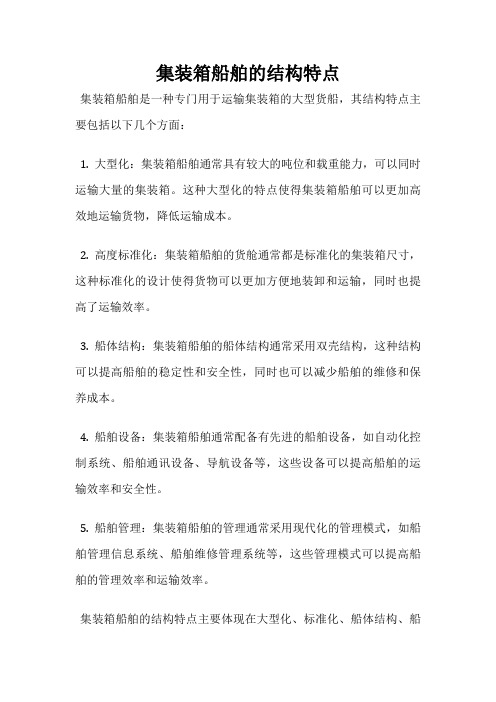
集装箱船舶的结构特点
集装箱船舶是一种专门用于运输集装箱的大型货船,其结构特点主要包括以下几个方面:
1. 大型化:集装箱船舶通常具有较大的吨位和载重能力,可以同时运输大量的集装箱。
这种大型化的特点使得集装箱船舶可以更加高效地运输货物,降低运输成本。
2. 高度标准化:集装箱船舶的货舱通常都是标准化的集装箱尺寸,这种标准化的设计使得货物可以更加方便地装卸和运输,同时也提高了运输效率。
3. 船体结构:集装箱船舶的船体结构通常采用双壳结构,这种结构可以提高船舶的稳定性和安全性,同时也可以减少船舶的维修和保养成本。
4. 船舶设备:集装箱船舶通常配备有先进的船舶设备,如自动化控制系统、船舶通讯设备、导航设备等,这些设备可以提高船舶的运输效率和安全性。
5. 船舶管理:集装箱船舶的管理通常采用现代化的管理模式,如船舶管理信息系统、船舶维修管理系统等,这些管理模式可以提高船舶的管理效率和运输效率。
集装箱船舶的结构特点主要体现在大型化、标准化、船体结构、船
舶设备和船舶管理等方面,这些特点使得集装箱船舶成为现代化海运业中不可或缺的一部分,为全球贸易和经济发展做出了重要贡献。
- 1、下载文档前请自行甄别文档内容的完整性,平台不提供额外的编辑、内容补充、找答案等附加服务。
- 2、"仅部分预览"的文档,不可在线预览部分如存在完整性等问题,可反馈申请退款(可完整预览的文档不适用该条件!)。
- 3、如文档侵犯您的权益,请联系客服反馈,我们会尽快为您处理(人工客服工作时间:9:00-18:30)。
文档来源为:从网络收集整理.word版本可编辑.欢迎下载支持.大型集装箱船的结构特点及其操纵分析[摘要]大型集装箱船是远洋货物运输重要的运载工具,对其操纵性能的了解直接关系到运输效率及航行安全。
本文根据一些前人资料结合笔者自己所学的知识简要的介绍了集装箱船的历史及通过对大型集装箱船的船型、侧推器、风压力、旋回性、加速、减速及停船性能的分析,并在船型、风压力和旋回性上与大型油船、散货船进行比较,总结出大型集装箱船具有旋回性较差、舵力和舵力转船力矩较大、风压差较大、船速较高、倒车停船性能较好等操纵特点。
根据这些特点,在进出港的操纵过程中,为了减小下风漂移,可适当提高船速,在接近码头过程中适时进行倒车减速或用拖船协助减速。
实践表明,这些策略对实际操纵具有指导意义。
可以为在集装箱船上工作的海员们提供一些专业性的参考。
[关键字]集装箱船结构特点操纵性航行安全Large container ship’s structural characteristics and analysis of itsmanipulation[Abstract] Large ocean-going cargo container ship is an important means of delivery, understanding its maneuverability is directly related to transport efficiency and safety of navigation. Information according to some combination of the previous paper the author learned in his brief introduction to the history of container ships and large container ship by ship, tunnel thrusters, wind pressure, gyration, acceleration, deceleration and stopping performance analysis, and In the ship, the wind pressure and the gyration with large oil tankers, bulk carriers were compared, summed up the large container ships with a cycle of poor rudder force and moment of a larger rudder, turned the ship, the wind pressure greater, speed high, reversing stopping manipulation features such as better performance. According to these characteristics, manipulation of the process in and out of port, in order to reduce downwind drift, it is appropriate to improve the speed of the ship, near the Pier during the slowing down or reversing a timely manner to assist with the tug to slow down. Practice shows that these strategies provide guiding significance for the actual manipulation of ship. And it could provide some professional reference for the seafarers working on container ship.[Key words] container ship structural features maneuverability Navigation Safety目录引言................................................................................................ 错误!未定义书签。
第一章集装箱船概论.................................................................. 错误!未定义书签。
1.1集装箱船大型化的发展历程............................................................. 错误!未定义书签。
1.2 大型集装箱船的市场介绍................................................................ 错误!未定义书签。
第二章大型集装箱船的结构分析.............................................. 错误!未定义书签。
2.1 大型集装箱船的船型特点及其对船舶操纵性能的影响................ 错误!未定义书签。
........................................................................................................... 错误!未定义书签。
........................................................................................................... 错误!未定义书签。
........................................................................................................... 错误!未定义书签。
........................................................................................................... 错误!未定义书签。
2.2 大型集装箱船的侧推器.................................................................... 错误!未定义书签。
2.3大型集装箱船的风压力..................................................................... 错误!未定义书签。
第三章大型集装箱船的操纵性.................................................. 错误!未定义书签。
3.1 旋回性................................................................................................ 错误!未定义书签。
........................................................................................................... 错误!未定义书签。
3.1.2 旋回过程中的速度降低和旋回时间..................................... 错误!未定义书签。
3.2大型集装箱船的加速、减速和停船性能......................................... 错误!未定义书签。
第四章大型集装箱船的一些安全操作.................................... 错误!未定义书签。
4.1用好先进的导航设备......................................................................... 错误!未定义书签。
4.2 采用车速避让时需大幅度................................................................ 错误!未定义书签。
4.3熟悉船舶的操纵数据应用在实践中................................................. 错误!未定义书签。
4.4 大风浪中的注意事项........................................................................ 错误!未定义书签。
4.5 抵港前根据船舶密度适时调整船速................................................ 错误!未定义书签。
4.6 对小渔船的避让................................................................................ 错误!未定义书签。
4.7 把握船舶驾驶员的避碰心理............................................................ 错误!未定义书签。
结论................................................................................................ 错误!未定义书签。
致谢辞............................................................................................ 错误!未定义书签。
参考文献........................................................................................ 错误!未定义书签。
引言集装箱船舶首次出现于20世纪50年代,此后国际海上集装箱运输曾经历几代的发展。
